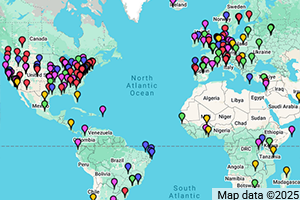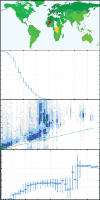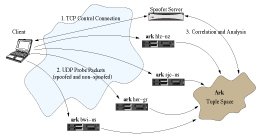Current Monitor Status and Statistics


(click on map for interactive monitors map and graphs for statistics)
Introduction
CAIDA deploys and maintains a globally distributed measurement platform we call Archipelago (Ark). We grow the infrastructure by distributing hardware measurement nodes (typically Raspberry Pi systems) with as much geographical and topological diversity as we can to improve our view of the global Internet. In 2024 we began to support software-based versions of Ark nodes. In addition to running canonical measurements in the background to support the research community, our primary goals with the Ark infrastructure are to:
- allow vetted measurements on a security-hardened distributed platform.
- reduce the effort needed to develop, deploy, discover, and dissect sophisticated large-scale measurements
Ark is tailored for distributed measurements that require communication and coordination. Ark operates several longitudinal measurement campaigns whose results we curate into community data sets of annotated Internet topology at multiple granularities. (Macroscopic Internet Topology Data Kit (ITDK).) We also support vetted measurement experiments, with the goal of lowering the barrier to testing and evaluating novel and interesting measurement techniques. We list current and recent measurement experiments below, and archive a list of historical measurements and experiments.
Ongoing Measurements
-
The Spoofer Project: Ark monitors participating in the Spoofer Project helped measure the Internet's susceptibility to spoofed source address IP packets. The monitors gather data on IP spoofing by receiving potentially spoofed traffic and forward it on to the Spoofer Project's server for analysis. The MANRS Observatory depends on these Spoofer measurements.
-
Scamper: To provide timely, regular data, several categories of measurements run on an ongoing basis driven by CAIDA's mission, in part, to provide macroscopic insights into Internet infrastructure, behavior, and evolution. The team-probing experiment performs traceroute measurements using scamper, a powerful and flexible active measurement tool supporting IPv4, IPv6, traceroute, and ping. Scamper supports TCP-, UDP-, and ICMP-based measurements and Paris traceroute variations.
-
Internet Topology Discovery: Using teams of geographically distributed Ark monitors we divide the probing work among teams to conduct coordinated, large-scale traceroute-based topology measurements. IPv4: We probe all routed /24 networks in the IPv4 address space from a team of 160 monitors probing over 10 million /24's (that is, the full routed address space subdivided into /24's) at 100pps. The Ark IPv4 Routed /24 Topology Dataset.
-
IPv6: For each probed path, we collect the IP address, RTT, reply TTL, and ICMP responses for all hops, including intermediate hops. Each Ark monitor probes all announced IPv6 prefixes (/48 or shorter) once every 48 hours. Prefixes are randomly ordered in such a way that a given monitor never probes the same prefix within 16 hours across cycle boundaries. The Ark IPv6 Topology Dataset.
- Border mapping using Ark vantage points to research and develop measurement techniques to accurately infer the presence of interdomain links for the network hosting the Ark vantage point. Our approach combines our experience in Internet-scale topology discovery and alias resolution, as well as our algorithms to infer routing relationships between networks, to accurately label interdomain routers with their owners.
We distribute the results of these measurements as well as others in various topology related datasets. For a complete list of CAIDA data, please see the CAIDA Data Overview page.
Ark-generated datasets
The CAIDA Resource Catalog lists collection of Ark tools and datasets generated from the Ark infrastructure, as well as published papers that made use of Ark-related data sets.
Funding Support



Support for the Archipelago Measurement Infrastructure project is provided by the Defense Advanced Research Projects Agency (DARPA) cooperative agreement HR00112020014 Performance Evaluation Network Measurements and Analytics, the Department of Homeland Security (DHS) cooperative agreement FA8750-18-2-0049 Advancing Scientific Study of Internet Security Topological Stability, S&T contract HHSP 233201600012C Science of Internet Security: Technology Experimental Research, S&T contract NBCHC070133 Supporting Research Development of Security Technologies through Network Security Data Collection, and S&T cooperative agreement FA8750-12-2-0326 Supporting Research and Development of Security Technologies through Network and Security Data Collection, and the National Science Foundation (NSF) grants CNS-0958547 Internet Laboratory for Empirical Network Science, CNS-1513283 Internet Laboratory for Empirical Network Science: Next Phase, CNS-1901517 Strategies for Large-Scale IPv6 Active Mapping, CNS-1925729 Facilitating Advances in Network Topology Analysis, CNS-2120399 Integrated Library for Advancing Network Data Science, OAC-1724853 Integrated Platform for Applied Network Data Analysis, and OAC-2131987 Designing a Global Measurement Infrastructure to Improve Internet Security. The U.S. Government is authorized to reproduce and distribute reprints for Governmental purposes notwithstanding any copyright notation thereon. The views and conclusions contained herein are those of the authors and should not be interpreted as necessarily representing the official policies or endorsements, either expressed or implied, of DARPA, DHS, NSF, or the U.S. Government.
Questions about Ark?
See our Frequently Asked Questions for sites interested in hosting an Ark monitor to see common questions, but please send questions or comments regarding Ark to ark-info@caida.org if they haven't been addressed by the FAQ.


 Archipelago (Ark): CAIDA's active measurement infrastructure serving the network research community since 2007.
Archipelago (Ark): CAIDA's active measurement infrastructure serving the network research community since 2007.
